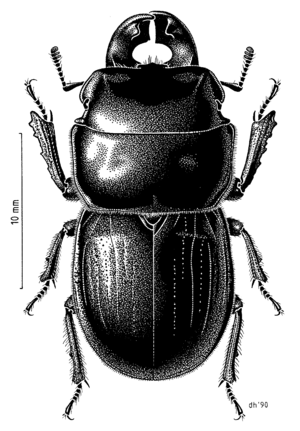Geodorcus sororum facts for kids
Quick facts for kids Geodorcus sororum |
|
|---|---|
 |
|
| Illustration by Des Helmore | |
| Conservation status | |
 Nationally Critical (NZ TCS) |
|
| Scientific classification | |
| Genus: |
Geodorcus
|
| Species: |
sororum
|
The Geodorcus sororum is a large, special type of stag beetle. It cannot fly, which means it stays on the ground. This beetle belongs to the Lucanidae family.
It was first found in 1973 by Mr. A. Wright. He was exploring Middle Sister Island, also known as Te Awanui. This island is one of The Sisters Islands/Rangitatahi. These islands are part of the Chatham Islands in New Zealand. The very first beetle found is kept in the New Zealand Arthropod Collection. A scientist named Beverley Holloway officially described this beetle in 2007. The name sororum comes from Latin and means "belonging to the sisters."
Contents
What Does This Beetle Look Like?
This beetle can be from 18.0 to 28.5 millimeters long. This measurement includes its mandibles, which are like large jaws. Females are a bit smaller, from 19.4 to 24 millimeters long.
The Geodorcus sororum has a shiny outer shell. Its color can be reddish-black or completely black. Its wing covers, called elytra, are smooth. They do not have clear ribs or ridges. This helps tell it apart from another beetle, G. capito, also found in the Chatham Islands.
Male and female Geodorcus sororum look different. This is called sexual dimorphism. Males are generally bigger than females. Their mandibles also have different shapes and sizes.
Scientists have studied the DNA of these beetles. They found that G. sororum and G. capito are closely related. They share a common ancestor. These two island species are more closely related to each other than to other Geodorcus beetles on mainland New Zealand. The G. sororum beetles are very similar to each other genetically. This means they have low genetic diversity.
Where Does This Beetle Live?
This special beetle has only been seen on Middle Sister Island. This island is about 19 kilometers northwest of Chatham Island. Scientists have found these beetles from near sea level up to 40 meters high.
Middle Sister Island is also a nesting place for large seabirds. These birds include the northern royal albatross and Buller's albatross.
Its Home: Middle Sister Island
Middle Sister Island does not have many plants. It mostly has coastal herbs and ice plant. Other types of Geodorcus beetles usually live in rotten logs. But there are no trees on the Sisters Islands.
The Sisters Islands are two tall, pyramid-shaped rocks. They are about 30 meters high. They have only a few small bushes. Many seabirds visit these islands.
What Does It Eat?
Most Geodorcus beetle larvae eat decaying wood. They also eat the fungi that help wood break down. However, Geodorcus sororum larvae must eat something different. This is because Middle Sister Island only has small shrubs and herbs. There are no large trees or decaying wood.
Adult Geodorcus sororum beetles also need a different food source. They cannot eat what other beetles in their group eat. This is due to the lack of woody plants on their small island. Luckily, the island has soil rich in humus. This type of soil allows the beetles to complete their full life cycle.
Protecting This Special Beetle
All Geodorcus species are protected by law. The 1953 Wildlife Act makes it illegal to collect or harm them. This means they are absolutely protected.
The Geodorcus sororum is considered "nationally critical." This is its conservation status. It has this status because its population is very small. It also lives in only one place: Middle Sister Island.
The Sisters Islands currently have no rodents like rats or mice. These islands are sometimes visited by birdwatchers. If rodents were accidentally brought to the island, it would be very bad for this beetle. It could cause a disaster for the species.
Images for kids



